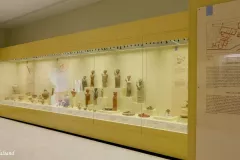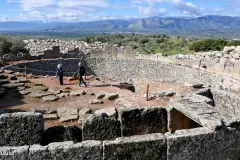The Archaeological Sites of Mycenae and Tiryns are representatives of a civilisation that dominated the eastern Mediterranean 3500 years ago.
The UNESCO World Heritage List includes over a thousand properties. They have outstanding universal value and are all part of the world’s cultural and natural heritage.
Official facts
- Official title: Archaeological Sites of Mycenae and Tiryns
- Country: Greece
- Date of Inscription: 1999
- Category: Cultural
UNESCO’s World Heritage Centre’s short description of site no. 0941:
The archaeological sites of Mycenae and Tiryns are the imposing ruins of the two greatest cities of the Mycenaean civilisation, which dominated the eastern Mediterranean world from the 15th to the 12th century B.C. and played a vital role in the development of classical Greek culture. These two cities are indissolubly linked to the Homeric epics, the Iliad and the Odyssey , which have influenced European art and literature for more than three millennia.
About Mycenae
Remember Troy, the beautiful Helen, Achilles and Odysseus? In Greek mythology, the Greeks waged a war against the city of Troy after prince Paris of Troy took Helen from her husband Menelaus, king of Sparta. Menelaus’ brother was Agamemnon, the king of Mycenae. Agamemnon gathered a large fleet and set sail for Troy to liberate Helen and avenge the insult committed by Paris. This drama, and the involved mythical and mythological persons and their actions, were forever made famous by Homer, as well as other storytellers.
Well, Agamemnon’s residence was the citadel of Mycenae. Along with the neighbouring fortress of Tiryns, it was the most important city in the Mycenaean civilisation. Today, you are able to go there and soak in the atmosphere of Agamemnon and his contemporaries.
My visit
I spent the Easter week of 2023 on a road trip from Athens to World Heritage Sites to the west and north. I had stayed the night in Nafplio, a pleasant town in the Saronic Gulf of Peloponnese and drove 25 km inland to the Mycenae archaeological site. Tyrins is by the way much closer to Nafplio but to me of lesser interest.
Mycenae is easy to visit. There is a discretely placed museum to the left as we leave the parking area. It does not hold many objects, but seek out (the copy of) Agamemnon’s death mask in gold. You will discover it in one of the pictures below. One should know that the mask is not actually of Agamemnon.
Next, head uphill for the entrance. It carries the name of the Lion gate and one will easily see the reason why. The other significant finding inside the gate, are the tombs to the right. After this there are steps, viewing platforms, wooden and gravelled walkways around the hill. Once there was a citadel, now very little remain. On the other hand, it was easy to understand that this would be a very strategic place to build a fortress. In addition, the view across the plain is amazing.
To me, the most important experience was to stand on top of a citadel that once was the most important centre of the world, 3500 years ago. At least from a European point of view.















